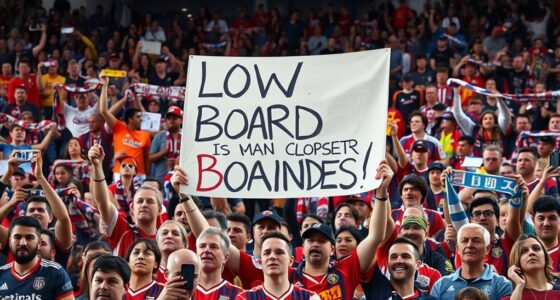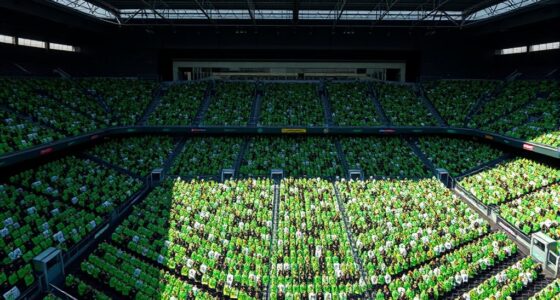Community-owned clubs like FC Barcelona give supporters a real stake in the club’s future through shared ownership and democratic decision-making. Founded in 1899, Barcelona emphasizes member participation, transparency, and community values over profit. This approach strengthens club identity, loyalty, and global influence while promoting long-term sustainability. Challenges like governance complexity and financial pressures exist, but the model inspires many around the world. To understand how this unique system works and what lessons it offers, continue exploring.
Key Takeaways
- FC Barcelona was founded in 1899 with a democratic ownership model, allowing members to participate in decision-making.
- The club emphasizes community values, transparency, and shared ownership, fostering strong supporter loyalty and identity.
- Members have voting rights influencing leadership elections, strategic plans, and major club decisions.
- The club promotes social engagement through digital platforms and community involvement initiatives.
- Financial transparency and community investment are central to FC Barcelona’s sustainable, community-driven approach.
The Origins and History of FC Barcelona’s Community Model

FC Barcelona’s community model began in 1899 when a group of football enthusiasts, led by Joan Gamper, founded the club with the vision of creating a club owned by its members rather than a single owner or corporation. From the start, the club emphasized club membership, allowing supporters to join and become part-owners. These members gained voting rights, giving them a say in major decisions, including electing the club’s board. This structure fostered a sense of collective ownership and democratic control, making FC Barcelona unique among football clubs. Over time, the community ownership model has strengthened the club’s identity, ensuring that decisions reflect the desires of its members rather than external investors or shareholders. This history remains central to Barcelona’s ethos today. The community model has contributed to the club’s resilience and enduring popularity.
How Shared Ownership Shapes Club Identity

How does shared ownership influence a club’s identity? It creates a deep sense of shared identity, strengthening club loyalty among supporters. When members own part of the club, they feel personally connected, making the club’s values and history part of their own. This collective pride fosters unity and perseverance through ups and downs. To illustrate, consider this table:
| Aspect | Effect on Club Identity | Impact on Club Loyalty |
|---|---|---|
| Ownership structure | Promotes shared responsibility | Builds trust and commitment |
| Fan involvement | Encourages active participation | Enhances emotional attachment |
| Community focus | Reinforces local pride | Boosts long-term loyalty |
| Decision-making | Reflects member interests | Creates shared purpose |
| Cultural values | Upholds tradition and identity | Inspires collective pride |
Shared ownership hence shapes a resilient, united club identity rooted in shared values and loyalty. Additionally, the governance model of shared ownership encourages transparency and accountability, further strengthening supporters’ confidence in the club.
Democratic Governance and Member Participation

Democratic governance empowers club members by giving them a voice in decision-making processes, fostering a sense of ownership and responsibility. As a member, your participation is essential—fan participation through voting mechanisms ensures your opinions shape major club decisions. These voting processes enable members to influence everything from leadership elections to strategic plans, creating transparency and accountability. Your engagement strengthens the club’s democratic foundation, making decisions more representative of the community’s interests. By actively participating, you help uphold the club’s values and ensure that decisions reflect the collective will. This structure not only promotes inclusivity but also builds loyalty, as members see their involvement directly impact the club’s future. Democratic governance turns fans into stakeholders, fostering a shared sense of purpose and community. Additionally, fan engagement plays a crucial role in maintaining the club’s cultural identity and long-term sustainability.
Financial Transparency and Community Investment

Financial transparency is essential for building trust between community-owned clubs and their members. When you clearly share details about income, expenses, and decision-making, members feel more confident in the club’s management. Transparency is especially important in areas like player transfers and stadium development, where large sums are involved. Open reporting on these activities ensures members understand how funds are allocated and invested back into the club. Here’s a quick overview:
| Aspect | Explanation |
|---|---|
| Player Transfers | Transparent deals prevent conflicts and promote trust. |
| Stadium Development | Clear budgets and progress reports keep members informed. |
| Financial Reporting | Regular updates boost confidence in management. |
| Member Contributions | Openness about how member funds are used. |
| Accountability | Ensures responsible financial decisions. |
Challenges and Limitations of the Community Model

You might face governance complexities as decision-making becomes more layered and time-consuming. Conflicts can arise when community members disagree on priorities or leadership. Additionally, maintaining financial sustainability can be tough without the large resources available to traditional ownership models. Moreover, managing affiliate relationships effectively is essential to generate revenue and ensure transparency in financial dealings.
Governance Complexities and Conflicts
While community-owned clubs aim to foster collective decision-making, they often face significant governance challenges. Power struggles can emerge as multiple stakeholders with differing visions vie for influence, making conflict resolution difficult. Decision-making processes tend to be slow, as obtaining consensus among diverse members takes time and effort. These disagreements can stall vital club initiatives or lead to internal divisions. Balancing the interests of passionate supporters with the club’s long-term sustainability requires careful management. Leadership must navigate complex relationships and guarantee transparency to prevent conflicts from escalating. Additionally, the governance structures employed significantly impact the club’s ability to manage conflicts effectively. Ultimately, the community model’s success depends on establishing clear governance structures that facilitate effective communication and conflict resolution, minimizing disputes that threaten to undermine collective efforts.
Financial Sustainability Challenges
Community-owned clubs often struggle to maintain financial stability because relying on member contributions and local support can be unpredictable and insufficient for covering all expenses. Stadium financing is a major challenge, as funding new or upgraded facilities demands significant capital, often beyond what members can provide. Merchandise branding offers revenue opportunities but depends on global appeal and marketing strategies. Without large commercial deals, these clubs risk financial shortfalls that threaten their sustainability. To illustrate, consider this:
| Revenue Source | Challenges | Opportunities |
|---|---|---|
| Stadium financing | High costs, funding delays | Public-private partnerships |
| Merchandise branding | Limited international reach | Strategic marketing campaigns |
| Ticket sales | Fluctuations in attendance | Community engagement |
| Sponsorships | Competition from larger clubs | Local business partnerships |
Additionally, establishing financial resilience is crucial for long-term viability in the community model.
Comparing FC Barcelona’S Approach With Traditional Clubs

FC Barcelona’s unique ownership structure sets it apart from traditional clubs, which are typically owned by private investors or corporate entities. As a member-owned club, you’re directly involved through fan participation, giving you a voice in major decisions and club direction. This model fosters a strong sense of community and loyalty that’s reflected in club branding, making it more than just a sports team—it’s a shared identity. In contrast, traditional clubs often prioritize profit, which can limit fan influence and focus more on commercial success than community engagement. With Barcelona’s approach, you’re part of a collective that values transparency and democratic governance, strengthening your connection to the club and reinforcing its social and cultural significance. Regular use of Glycolic Acid in skincare routines exemplifies a commitment to improving skin health through effective, science-backed methods.
The Global Influence of Barcelona’s Community Ownership

Barcelona’s community ownership has inspired fans worldwide to connect more deeply with their clubs. This model promotes international fan engagement and demonstrates how democratic governance can work in sports. As a result, more clubs are considering similar approaches to foster loyalty and transparency. Lesser-known spots within the broader community can also enhance the sense of belonging and shared purpose among supporters.
International Fan Engagement
Have you ever wondered how a football club’s community ownership can extend its influence beyond borders? Barcelona’s model fosters international fan engagement through several key factors. First, it inspires global fan activism, encouraging supporters worldwide to participate in club initiatives. Second, Barcelona’s focus on youth development attracts international youth talent, creating a diverse, global community. Third, the club’s inclusive approach helps fans feel connected regardless of location, strengthening loyalty and involvement. This widespread engagement isn’t just about supporting a team; it’s about building a shared identity rooted in community values. Additionally, the club’s use of digital platforms enhances communication and participation with fans around the world. As a result, the club’s influence grows, inspiring other clubs to adopt similar community-driven strategies that transcend national boundaries and foster a global sense of belonging.
Model for Democratic Sports
How does a sports club embody democratic principles and serve as a model for participatory governance? By giving members a voice, you foster transparency and shared decision-making. FC Barcelona exemplifies this through its community ownership, where fans influence major choices, including player development strategies. This democratic structure encourages active participation, ensuring the club aligns with supporters’ values. It also enhances marketing strategies by strengthening loyalty and engagement, driving revenue through grassroots support. Such a model allows you to prioritize long-term growth over short-term profits, creating a sustainable environment. As a result, Barcelona’s approach inspires other clubs worldwide to adopt democratic governance, emphasizing community involvement, transparency, and shared responsibility—key elements for a resilient, inclusive sports organization. Additionally, fostering a sense of creative practice among supporters can lead to innovative ways of engaging with the club’s culture and activities.
Lessons and Potential Applications for Other Clubs

The success of community-owned clubs offers valuable lessons that other organizations can adapt to their own contexts. To harness these benefits, focus on three key areas: 1. Prioritize fan engagement by fostering transparent communication and shared decision-making, which builds loyalty and trust. 2. Invest in youth development to cultivate local talent, ensuring long-term sustainability and community support. 3. Promote democratic governance structures that empower members, making them feel invested and motivated to contribute. Additionally, incorporating digital literacy programs can enhance communication channels and foster playful engagement among diverse community members.
Frequently Asked Questions
How Are Community Members Involved in Daily Club Operations?
You’re actively involved in daily club operations through fan engagement and governance transparency. As a community member, you can participate in decision-making processes, attend meetings, and voice your opinions. Your engagement helps shape the club’s direction, ensuring it stays true to its community roots. Transparency keeps you informed about club activities and finances, fostering trust. Your involvement creates a stronger bond, making you feel like a true part of the club’s ongoing success.
What Legal Structure Supports FC Barcelona’S Community Ownership?
Legal framework lays the foundation for FC Barcelona’s community ownership, supporting member voting and collective control. You see, this structure ensures that members, or socios, actively influence decisions through democratic processes. By establishing a clear legal framework, the club empowers members to participate directly, preserving its communal character. This legal support sustains the shared spirit and safeguards the club’s independence, making it a true community club.
How Does Community Ownership Impact Club Decision-Making Speed?
You’ll find that community ownership slows decision-making because democratic processes require input from many stakeholders. This stakeholder influence means decisions often go through multiple approvals, making the process more inclusive but less agile. While it fosters transparency and collective involvement, it can delay urgent actions. Overall, community ownership encourages thoughtful, democratic processes, but it’s a trade-off between speed and shared control.
What Mechanisms Prevent Conflicts Among Community Members?
You might think conflicts among community members are inevitable, but clever fan engagement and transparency mechanisms keep disputes at bay. These tools foster open dialogue, ensuring everyone feels heard and valued. By promoting shared decision-making and clear communication, they prevent misunderstandings from spiraling into chaos. Ironically, it’s this openness that strengthens the club’s unity, proving that transparency isn’t just good for trust—it’s essential for harmony.
Can Other Clubs Realistically Adopt the FC Barcelona Model?
You might wonder if other clubs can adopt the FC Barcelona model. While it’s possible, it requires strong fan participation and a focus on financial sustainability. You’ll need a dedicated community willing to invest time and resources, plus transparent governance to guarantee success. However, replicating this model depends on your club’s size, location, and supporter base. It’s not a one-size-fits-all solution, but with commitment, it’s achievable.
Conclusion
Embracing FC Barcelona’s community model proves that shared ownership isn’t just a business choice—it’s a rallying cry for unity and identity. As you consider other clubs, remember: can a community’s passion and democratic spirit truly transform the game? Like a tapestry woven with countless voices, this approach shows that collective power can elevate a club beyond mere competition—turning it into a symbol of shared dreams and enduring loyalty.









